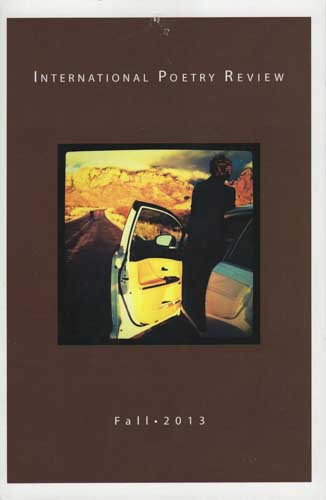International Poetry Review – Fall 2013
I cannot remember when I have ever made reading poetry in translation part of my reading habits, but after the experience of reading this issue of International Poetry Review, I am humbled and convinced that I have been missing out on unique and profound experiences with poems that are significant and at times transcendent.
I cannot remember when I have ever made reading poetry in translation part of my reading habits, but after the experience of reading this issue of International Poetry Review, I am humbled and convinced that I have been missing out on unique and profound experiences with poems that are significant and at times transcendent.
The space between the original poem and its English translation is a place where readers put their trust—in the accuracy and authenticity of the translation and the skill and talent of the translator. The size of this space varies, but it never disappears. In this issue, the space between is a sliver, an afterthought that does not impede the experience of reading poems that inspire or supersede the art of the original poems.
Diving into the poems in this issue, I am surprised to find that the first is a translation of Horace’s “Epistulae, I, VIII.” I am now convinced that Latin is no longer a dead language but has been revived. Fred Chappell’s translation subdues the Latin lines and brings them into the 21st Century complete with technology without losing its origins. In his poem, “Low Ebb,” which he states is “freely adapted from Epistles 1.8,” Chappell begins expectedly with “O Muse,” closely followed by an entreaty for the muse to
please email Kathryn Stripling Byers
My warm regards and, if she should inquire,
Tell her, one more season discovers Fred
Crosswise with the world and his own head.
Chappell has resurrected the Latin so that it may easily live and breathe in the present. I—not being a student of Latin—am happy to put my trust in Chappell’s freely adapted poem and enjoy the experience.
The translations of poems that follow Chappell’s adaptation seem to be more closely connected to their originals and bring their language through a tunnel to another perspective via English (language being perspective after all) as re-created art.
Michael Goldman’s translation from Danish of Benny Andersen’s “Just Before Spring” gives readers a fresh look at the season and explains that “The quiet is almost ripe, / opening like a seed.” In seconds I am transported to Denmark, imagining a “freezing morning” filled with colors I cannot see. I am assured at the end that the silence will not last: “One more drop of silence / and the air will be full of song.” I anticipate spring after a long winter in a new, breathless way for having experienced Andersen’s poem in Goldman’s skilled hands.
Perhaps Rocío Cerón’s “Cumbres—Tercer Sector—” is more than a list of images. In English, the lines are items illuminating a story, one I want to know. I grasp for words to hang my understanding on. From these lines, my interest is awakened:
Pleura.
Before impact.
Maybe bile on crest peak vertex.
Pleura.
I recognize repetition and imagery, the steadfast elements of poetry. I know how form and function work together to create meaning; this poem, though, makes me wonder if I know my own mother tongue. I need more, but I am swimming in the language of images offered by Anna Rosenwong’s translation. Then I ask myself how much is necessary for me to understand my visceral response to a “Growing mothertongue” or “sunset in mauve” or “wounded flagstones”?
Yet another translation engenders an intense emotional reaction with its stark images personified as a ghostlike storyteller. In Jonathan Harrington’s translation of “The Hearth Weeps,” from Mayan and Spanish by Briceida Cuevas Cob, my trust is firmly placed in both poets as I enter the Mayan world where
The fireplace tells me its story.
Its breath slaps my face.
It shows me its wounds,
its scorched face
Reading Nancy Naomi Carlson’s translation of Suzanne Dracius’s “Anamnésie Propitiatoire” is an occasion to travel to the Paris suburbs, to a specific zip code (this learned at the end of the poem in a footnote) where race and ethnicity reveal “Métissage and marronage” in the city and emerge in “Catharsis / Courageous / Propitious.”
From Paris we travel to Southern France reading poetry translated from Occitan, once widely spoken, now only in rural areas. From Dracius’s warlike Paris to Max Rouquette’s slower paced Provence, we find a balance and an intensity focused in a different direction. Jeannette Rogers translates Rouquette’s “Birds of the Air,” which observes birds at the end of a flight, perhaps a migration,
They came from the blind past
ending their flight
beside the silent water, frozen sky,
broad flower of autumn;
Against Dracius’s earlier images of “Gnomes versus dwarves / the war to end all wars,” Rouquette takes readers to a different place and a different atmosphere.
In his essay, “Shah Hussein: Translations & Conversations,” Naveed Alam asks himself, “Why translate Hussein? My tentative answer: To express an affinity, to explore through a kindred sensibility, to discover a poetic process and (re)examine my own aesthetics, to relive, revive a song through the sounds of a different language while preserving its emotional vitality.” This seems to be the list of goals for all of the translators in this fall issue.
[www.uncg.edu/llc/about/poetryReview.html]





